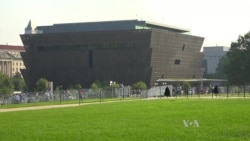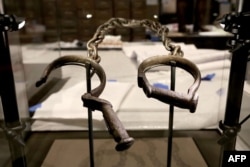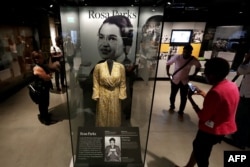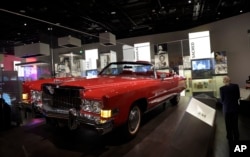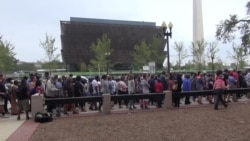Speaking at the dedication Saturday of a new U.S. museum devoted to the history of African-Americans, U.S. President Barack Obama said their history is central to America's history dating back to the country's traditional founding fathers.
"Too often we ignored or forgot the stories of millions upon millions of others who built this nation just as surely," Obama said.
At times brushing away a tear, Obama pointed out the highs and lows of being black in America, from slavery and Jim Crow segregation to voting rights and election of the first black president.
"We are not a burden on America, or a stain on America ... we are America. And that's what this museum explains," he told the thousands who had gathered on the National Mall for the event.
After years in the making, the newest museum on Washington's National Mall, the National Museum of African American History and Culture, officially opened to the public Saturday.
Wanda Moore attended the celebration with her daughter Celeste.
"A lot of people don't want to talk about slavery, but I think it's very important, because our ancestors came from Africa. They were brought over here," Moore said. "They were slaves, and I don't think it's something to be ashamed of. I think they're very strong that they made it this far."
With the current tensions in race relations, she said she thought the museum, with its artifacts and information, would allow for more thoughtful discussions on race.
Obama echoed that thought, saying the museum tells a story of America that will promote healing and reconciliation.
"By knowing this other story, we better understand ourselves and each other. It binds us together, it reaffirms that we are all Americans," he said.
WATCH: President Obama's full speech at museum dedication
The new museum "symbolizes all of the contributions, the culture and the crisis of black America," the Rev. Howard-John Wesley, pastor of Alfred Street Baptist Church in Alexandria, Virginia, whose members donated $1 million to the museum, told the Associated Press. "It's a beautiful thing, especially in this day and time when we're fighting to remind ourselves how important black lives are."
Alex Davis from Michigan, who participated in civil rights demonstrations in the 1960s, told VOA he participated in his first march in 1962 while in college. "I joined that march and I never stopped."
"I think the kids today need to know that there was a history that needed to be changed. It's like I tell my kids: 'I march so you don't have to,' " Davis said.
WATCH: Related video report by Arash Arabasadi
Others at Saturday's ceremony included former President George W. Bush, who signed the bill authorizing construction of the facility in 2003, and U.S. Representative John Lewis of Georgia, a civil rights icon who called the bronze-colored museum "more than a building, it is a dream come true."
To officially open the museum, Obama and first lady Michelle Obama rang a bell from a historic African-American church.
On Friday, the president told a group of about 750 guests in the Grand Foyer of the White House, gathered to celebrate the museum's opening, that "the timing of this is fascinating."
The crowd, many of whom were African-American, laughed and applauded at the understatement.
The city of Charlotte, North Carolina, has been rocked by nights of protests following the police shooting of a black man Tuesday. Also this week, a court in Tulsa County, Oklahoma, charged a white police officer with manslaughter after she fatally shot an unarmed black man last week.
Continuing his remarks, Obama said, "In so many ways, it is the best of times. But in many ways, these are also troubled times. History doesn't always move in a straight line. And without vigilance, we can go backward as well as forward."
The new museum, first proposed by a group of black Civil War veterans in 1915, is situated among war memorials and cultural institutions, with a clear sight line to the U.S. Capitol.
"My hope is that, as people are seeing what's happened in Tulsa or Charlotte on television, and perhaps are less familiar with not only the history of the African-American experience, but also how recent some of these challenges have been, upon visiting the museum may step back and say, 'I understand. I sympathize. I empathize. I see why folks might feel angry and I want to be part of the solution, as opposed to resisting change,' " the president said.
Weekend of celebration
Friday's White House reception — attended by many of the museum's contributors — was the kickoff event in a weekend of festivities, which included an outdoor festival.
Nicholas Lorenz has been anticipating the opening for a long time.
"I heard about the museum before they broke ground, and we have been following their Facebook page for two or three years," Lorenz said of himself and his wife, both educators in Miami, Florida. "We got tickets through the [museum] website the morning they were made available. We got 24 tickets of the 30,000 they made available that day. Apparently, they all sold out within 45 minutes, so we feel lucky!"
The Lorenzes are a mixed-race couple: he is white, and his wife, Liz, is biracial. The distinction is "irrelevant" now, they say, but it would have been illegal in the United States just a few decades ago. To children of today, that part of history may seem unthinkable.
Painful past
Many of the stories in the museum are difficult to think about.
The lowest level of the museum deals with the arrival of Africans in North America — as slaves. Generations of blacks remained in bondage to white farmers for more than two centuries, and the racial divide that system created resonated throughout the Civil Rights Movement of the 1960s and the Black Lives Matter movement that has sprung up in response to conflicts between white police officers and black civilians today.
The museum's founding director, Lonnie Bunch, has been on the job since 2005 and had a part in deciding the museum's look: dark bronze-colored layers of metal, in contrast to the white Greek Revival structures that dominate the National Mall.
Bunch has said the building should reflect the troubled past the museum describes.
"I wanted a darker building," he told The New Yorker magazine in April. "There's always been a dark presence in America that people undervalue, neglect, overlook. I wanted this building to say that."
The museum's very location is a reminder of the dark past. While the National Mall, home to more than half of Washington's Smithsonian museums, is known as "America's front yard," it was also once home to slave pens, where human beings of African origin were held like cattle to be bought and sold.
Upward and outward
Because of height limits designed to preserve views of all the monuments, 60 percent of the museum is underground.
Visitors start in the basement, with the ugly history of the slavery era. As they advance to higher floors, the story grows more uplifting, although still fraught with conflict.
The narrative of upward movement is reflected in the architecture designed by British-Ghanaian architect David Adjaye. The building appears to rise from the ground, with exterior panels opening upward and outward toward the blue sky.
Upper levels tell the story of the Civil Rights Movement, when the federal government finally passed laws allowing blacks the same legal rights as whites.
Despite slavery being outlawed in 1864, it took a century for blacks to achieve full legal rights with whites in the Civil Rights Act of 1964. The Supreme Court decision removing barriers to interracial marriage, the issue that the Lorenzes might have faced, did not happen until 1967.
The top level of the museum, where light pours in and visitors can see a sweeping view of the Mall and the monuments, is a showcase for African-American art.
WATCH: Obama on importance of African-American museum
The Smithsonian Institution has other museums dedicated to American art and African art, but here, the mingled cultures are allowed to shine together.
The museum also features thousands of artifacts from famous African-Americans and everyday citizens. There are so many pieces that the museum plans to exhibit them on a rotating basis.
Media mogul Oprah Winfrey, ranked by Forbes magazine 21st among the world's richest women, was a major donor to the museum, contributing not only $20 million from her charitable foundation but also a pair of slave shackles from the mid-1800s, donated from her private collection of artifacts.
Ironically, the collection also includes a pair of handcuffs used in the arrest of Harvard scholar Henry Louis Gates, who was arrested outside his own home in Cambridge, Massachusetts, in 2009 by an officer mistakenly assuming Gates was a burglar.
Other artifacts in the collection include:
- Several items from a sunken slave ship excavated off the coast of South Africa.
- An entire slave cabin, originally found on Edisto Island in South Carolina.
- A hymnal and silk shawl owned by Harriet Tubman, an escaped slave who led hundreds of other escaped slaves to freedom through the Underground Railroad.
- The glass-topped casket used to display and bury the body of Emmett Till, a 14-year-old African American whose racially motivated torture and murder in 1955 touched off the Civil Rights Movement.
- A dress belonging to Rosa Parks, the woman who started the Montgomery Bus Boycott, one of the first acts of mass civil disobedience during the civil rights era.
- A PT-13D Stearman biplane trainer aircraft used by the U.S. Army Air Corps to train the Tuskegee Airmen, the nation's first black military flying unit.
- A trumpet played by jazz legend Louis Armstrong.
- A Cadillac convertible that belonged to rock ‘n’ roll singer Chuck Berry.
- Muhammad Ali's boxing gloves.
- A collection of costumes from the Broadway show “The Wiz.”
- A pair of size 22 tennis shoes owned by basketball star Shaquille O'Neal.
While the story the museum tells is often difficult and sometimes painful, Obama and museum founding director Bunch say the story of black Americans is relevant to all Americans.
Museum-goer Lorenz believes that, as well.
He said understanding the black experience was crucial to understanding what the United States is, even if some of the lessons it teaches are painful for whites to consider.
"This is an essential and foundational aspect of our shared culture and history," he said. "We welcome the opportunity to engage with all of it — the good and the bad. White guilt and white fragility have kept us from knowing our history for too long as it is."
More important, Lorenz said, ignoring history bars the way to progress. "Naming our history and fully facing its implications is the only way forward."
WATCH: Attendees of museum opening talk about historic event




